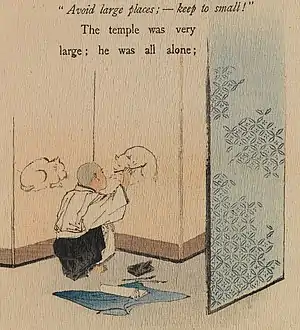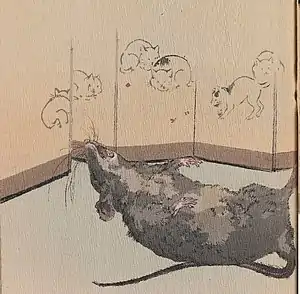The Boy Who Drew Cats
"The Boy Who Drew Cats" (Japanese: 猫を描いた少年, Hepburn: Neko wo egaita shōnen) is a Japanese fairy tale translated by Lafcadio Hearn, published in 1898, as number 23 of Hasegawa Takejirō's Japanese Fairy Tale Series.[1][2] It was later included in Hearn's Japanese Fairy Tales.[3]

The original title in Hearn's manuscript was "The Artist of Cats".[1] Printing it on plain paper as in the rest of the series did not meet with Hearn's approval, and this book became the first of a five-volume set by Hearn printed on crepe paper.[1] Illustrations were by the artist Suzuki Kason.[lower-alpha 1][1]
Synopsis
In a small village lived a farmer and his wife, described as decent folk. They have many children who are capable farm-hands, except for the youngest son who is intelligent but small and frail, and not suited for hard work. The parents decide the boy would be better off he became a priest, and he is accepted as an acolyte in training under the old priest of the village temple. Although the boy excelled as a student, he had the irresistible habit of drawing cats everywhere, including the margins of books, the temple's pillars, and all its screens,[lower-alpha 2] and is expelled. The priest warns the boy: "Avoid large places at night. Keep to the small".[5]

The boy did not want to return to his father's farm for fear of punishment, and instead, he travels to the temple in the neighboring village, twelve miles away, hoping to be admitted as an acolyte there, not realizing all the priests living there have long-ago been driven away by a giant goblin-rat, and a number of warriors have gone missing after attempt to eradicate the goblin at night. The boy enters the deserted temple, which is dusty and cobwebbed. But he finds many big white screens to draw on, and finding a writing box (containing a brush), he ground some ink (i.e., ground inkstick on an inkstone), and drew cats on them.[6]
Feeling drowsy, he was about to lie down to sleep by the screens, but recalls the old priest's words and climbs inside a little cabinet to go to sleep. During the night he hears horrible sounds of screaming and fighting. When morning comes and he finally climbs out, he discovers the corpse of the goblin-rat. As he wonders what could have killed it, he notices that all his cats now have blood on their mouths. He is hailed as a hero for defeating the monster, and grows up to be a famous artist.[7]
Origin
This tale was known from Tohoku to Chugoku and Shikoku regions under the title Eneko to Nezumi (絵猫と鼠, "The Picture-Cats and the Rat").[8] Some commentators trace the tale to the 15th century legends around Sesshū.[9]
It has been suggested that Lafcadio Hearn's version is a retelling, and has no original Japanese story which is an "exact counterpart".[10] Thus "in his English edition, Lafcadio Hearn retold it with a thrilling ghostly touch. In the original story, the acolyte becomes the abbot of the temple after the incident, but in Hearn's version, he goes on to be a renowned artist".[lower-alpha 3][4]
Analyses
The legends surrounding the eminent inkbrush artist priest Sesshū as a young acolyte has been compared to this folktale,[11] and it has been suggested the tale may derive from the legends around young Sesshū.[9]
Hearn stipulated that he would not contribute a story unless it would be "prettily illustrated" in publication,[12] and even though the choice of artist was not the author/translator's, Suzuki Kason's drawing catered to the American readers' taste for the fantastical, as in the example of the illustration showing the dead giant rat-ghoul.[13]
Explanatory notes
- The illustration of the byōbu screen (or rather, a tsuitate screen, on p. 4) is signed "Kason", allowing this artist to be identified.[4]
- Although the text says the boy was caught drawing on a "paper screen", the corresponding illustration shows he has drawn on a fusuma, or paper-covered sliding door.
- Quote from the Kyoto University of Foreign Studies pamphlet for the 2007 "Crepe-paper Book" exhibit.
References
- Citations
- Sharf (1994), pp. 46, 63
- Hearn (1898).
- Hearn (1918), pp. 29–35.
- "The Boy Who Drew Cats". Kyoto University of Foreign Studies Rare Books Exhibition. 2007. Retrieved July 13, 2019.
- Hearn (1898), pp. 1–6.
- Hearn (1898), pp. 9–12.
- Hearn (1898), pp. 14–18.
- Kang, Jihyun (康 志賢) (2006). 浮世絵に見る『東海道中膝栗毛』滑稽の旅 (特集 旅). Nihon Ukiyoe Kyōkai. Ukiyo-e Art: A Journal of the Japan Ukiyo-e Society (in Japanese). 151–152: 23.
- "Library Publishes Facsimile of Japanese Tale, Lafcadio Hearn's The Boy Who Drew Cats". Library of Congress Information Bulletin. 46 (48): 509. 1987.
- Guth (2008), p. 271, n22.
- Van Briessen, Fritz (1964) [1962]. The Way of the Brush: Painting Techniques of China and Japan. Tuttle. pp. 29–35.
- Sanki Ichikawa (1925). Some New Letters and Writings of Lafcadio Hearn. Kenkyusha. p. 320. Cited by Guth (2008), p. 274.
- Guth (2008), p. 274.
- Bibliography
- Hearn, Lafcadio (1898). The Boy who Drew Cats. Japanese fairy tale series 23. Suzuki Kason (illustr.). Tokyo: T. Hasegawa.
- —— (1918). "The Boy who Drew Cats". Japanese Fairy Tales. New York: Boni and Liveright. pp. 29–35.
- Guth, Christine M. E. (Spring–Autumn 2008). "Hasegawa's Fairy Tales: Toying with Japan". RES: Anthropology and Aesthetics. The University of Chicago Press on behalf of the Peabody Museum of Archaeology and Ethnology. 53–54 (53/54): 266–281. doi:10.1086/RESvn1ms25608821. JSTOR 2560882. S2CID 164285608.
- Sharf, Frederic Alan (1994). "drew+cats" "Takejiro Hasegawa: Meiji Japan's Preeminent Publisher of Wood-block-illustrated Crepe-paper Books". Peabody Essex Museum Collections. Peabody Essex Museum: 46, 63. ISSN 1074-0457.
External links
- Audio recording of "The Boy Who Drew Cats" - Downloadable and streaming audio formats.